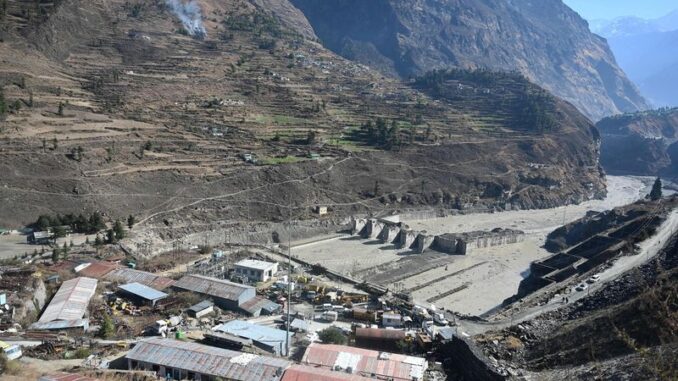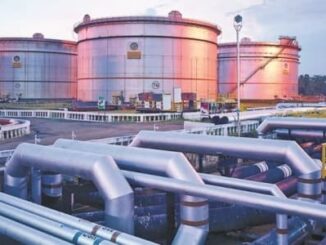
The flash flood in India’s Himalayan state of Uttarakhand which killed at least 34 people at the weekend has raised public anger over hydropower projects that the government considers essential to decarbonize the nation’s electricity generation.
The deluge triggered by a glacial burst near a small hamlet in the north Indian state last Sunday swept away bridges and hydropower stations, including the 520-megawatt Tapovan Vishnugad dam of NTPC Ltd. that was nearing completion. Experts say the incident, induced by the effect of global warming on melting glaciers, was made worse by construction of infrastructure.

A satellite image of NTPC’s Tapovan Vishnugad dam project taken on Feb. 10 shows the devastation caused by the flood.
Source: Maxar Technologies
“Hydropower projects, which use large-scale blasting, tree felling and tunneling, most certainly added to the proportion of the impact,” said Himanshu Thakkar, coordinator of the New Delhi-based South Asia Network on Dams, Rivers and People, which studies the social and environmental impact of water-related projects. “They became a force multiplier in the destruction.”
Heightened public concern about dams complicates India’s plan to wean the nation off coal, with its emission of greenhouse gases and toxic pollutants that are blamed for thousands of premature deaths each year. While the nation has made record investments in solar and wind power, hydroelectricity, with its ability to quickly ramp up and down, is seen as a vital component of an emission-neutral future to offset the intermittent supply from other renewable sources. Efforts to use natural gas, a relatively low-emission alternative to coal, have often proven too expensive in India.
But new large dam projects have come under increasing criticism worldwide in the past few decades for their ecological and social impact.

Army personnel climb down a makeshift ladder on the Tapovan dam on Feb. 9 during rescue efforts to locate missing workers.
Photographer: SAJJAD HUSSAIN/AFP
Uttarakhand, known for its Hindu temples and yoga retreats, has suffered deadly floods before. In June 2013, a massive cloudburst lasting several days led to torrential flooding in one of the state’s most popular pilgrimage areas. More than 5,000 people are thought to have been killed in the deluges, which prompted India’s top court to put a moratorium on new hydro dams in the state.
“The 2013 floods in Uttarakhand were supposed to be like India’s Fukushima moment for hydropower projects in the ecologically sensitive Himalayan region,” Debasish Mishra, a Mumbai-based partner at Deloitte Touche Tohmatsu. “The repeated occurrences of such events tell us that the risk of building such large projects is way too high.”

A stranded pilgrim is transported across a river using a rope rescue system in Govind Ghat in June 2013, when flash floods killed more than 5,000 people in the state.
Photographer: Manan Vatsyayana/AFP/Getty Images
India’s government added incentives in 2019 aimed at spurring construction of large hydropower projects, including longer debt-repayment terms and the potential to win funding for associated infrastructure like roads and flood defenses.
India should instead focus on technologies such as pumped storage, batteries and hydrogen for balancing the grid, Mishra said. As these technologies become economically viable, it will further weaken the case for large dams.
“There’s no doubt that hydropower dams need thorough environmental due diligence. But such mishaps shouldn’t hide the inherent advantages of such projects,” said S.D. Dubey, former chairman of India’s Central Electricity Authority. “These are sources of clean power, can help in grid balancing and can help reduce the impact from floods, if planned well. Had it not been for the Tehri dam, the impact of Uttarakhand floods in 2013 would have been far more devastating.”
Large hydro projects generated about 14% of India’s electricity in the six months ended in October, compared with 65% from coal and only 11% from other renewables, according to the government. While solar and wind power are growing rapidly, the proportion of power generated by big hydro projects has barely changed since 2007.
Other developing nations have embraced dams as a way to reduce reliance on expensive fossil fuels, despite the enormous cost of construction. Brazil gets more than 70% of its power generation from hydro, while 15 of China’s 17 biggest hydropower projects were completed since 2008.
India’s estimated hydro-electricity potential is 145 gigawatts, mostly in the band of northern states under the Himalayas. But social resistance to dams has led to several projects either being aborted or delayed, causing huge cost over-runs. The NTPC Tapovan project that was damaged at the weekend had already been delayed by about eight years.
“This incident should be an opportunity to scrap the NTPC project,” Thakkar said. “Hydropower was never socially acceptable, it was never ecologically viable. Now it’s not even economically viable.”
— With assistance by Sudhi Ranjan Sen



